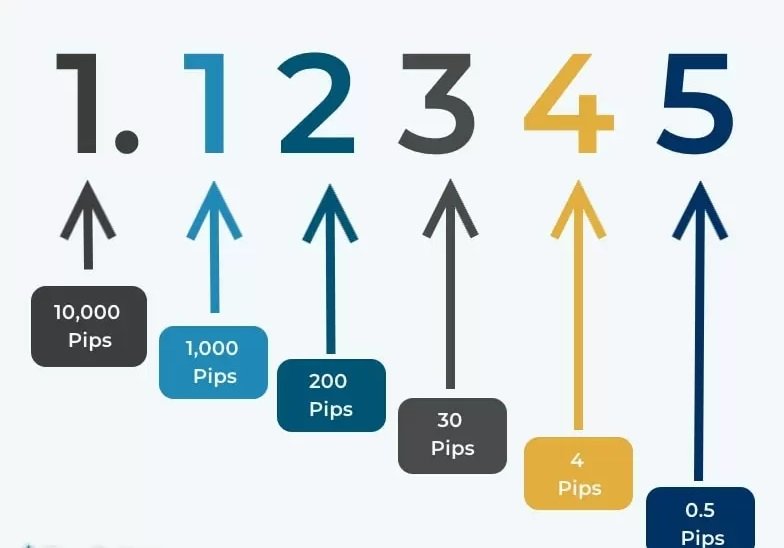Leveraging Pips in Your Forex Trading Strategy
Understanding and utilising pips is crucial for building an effective forex trading strategy.
According to the market convention, pips denote the smallest price change in a
currency pair's exchange rate. Mastering this can significantly boost performance. By
incorporating precise pip measurements into trading decisions, traders gain a deeper
comprehension of market movements, which can lead to enhanced efficacy. This article
explores various methods to incorporate pips into forex trading strategies, offering
traders valuable insights and practical guidance.
Spot Trading
Once you know what is a pip in forex, it's crucial to understand its role in spot trading.
This approach entails buying and selling currency pairs according to the prevailing
market prices. Pips measure the price fluctuations of these pairs, providing traders with
real-time data on value changes.
By closely monitoring pip movements, traders can determine the right times to enter or
exit trades, optimising their chances for profit or minimising potential losses. Consistent
tracking of its movements offers a clear view of market volatility, which is essential for
making informed trading decisions. Additionally, understanding how pips correlate with
market trends enables traders to forecast future price movements more accurately.
Futures and Forwards Trading
Even in futures and forwards trading, pips play a significant role. Although these
contracts have fixed exchange rates, real-time spot price movements are still tracked
using pips. These movements offer insights into the profitability of a trade. Significant
favourable changes in the spot price can indicate potential success for futures or
forward contracts. Thus, monitoring its movements allows traders to make well-informed
decisions about their positions and necessary adjustments.
This understanding helps traders hedge against risks by adjusting their strategies
accordingly, ensuring they can take advantage of favourable conditions while mitigating
losses in less favourable scenarios.
Leverage Trading
In this, the importance of pip movements is amplified. This method allows traders to
control a prominent position with a relatively small capital. Leverage magnifies the
impact of its changes, meaning even minor fluctuations can result in significant financial
outcomes. Therefore, precise tracking and prediction of pip movements are crucial for
managing risk and optimising returns in leverage trading.
Effective leverage can increase potential returns but necessitates a robust risk
management strategy to avoid substantial losses. Understanding the relationship
between leverage and its movements helps traders better plan their entry and exit
points.
Protecting Your Positions
Pips protect trading positions by stopping losses and taking profit orders. These tools
automatically close trades when the market moves beyond specified pip thresholds,
which the trader sets. By establishing these parameters, traders can shield their
investments from adverse market movements. Using pips to set these limits ensures
precision and supports a disciplined risk management approach. This strategy aids in
maintaining control over outcomes and preserving capital.
Regularly reviewing and adjusting these thresholds based on market conditions can
enhance the effectiveness of these protective measures. Understanding pip movements
and market dynamics is critical to setting realistic and effective stop loss and take profit
levels.
Market Analysis
Analysing market movements through pips provides critical insights into forex market
trends and dynamics. Traders can extend their analysis across various
timeframes—daily, weekly, monthly, or annually—to identify broader market patterns.
By examining pip movements over these periods, traders can detect trends, volatility,
and potential reversal points. This detailed analysis aids in strategic planning and helps
traders position themselves in the market.
Recognising these patterns through pip analysis is crucial for long-term investment
success. Integrating pip analysis with additional technical indicators provides a broader
perspective on market conditions, allowing traders to craft more advanced and effective
strategies.
Monitoring Economic Indicators
Economic indicators and their effects on currency pairs can be measured using pips.
Significant economic announcements, such as changes in interest rates or employment
data, often lead to substantial pip fluctuations. By carefully tracking these indicators and
understanding their potential effects on the market, traders can better predict and react
to price movements. Quantifying these movements in pips precisely explains how
economic events affect the forex market.
Furthermore, being informed about upcoming economic events and their anticipated
impact on pip movements allows traders to prepare and adjust their strategies. This
proactive approach aids in risk management and seizing opportunities that economic
news presents.
After knowing what is a pip in forex, mastering the use of pips in forex trading strategies
makes it easy to handle the complexities of the forex market. Integrating pips into these
strategies enhances precision, improves risk management, and boosts outcomes.
Understanding and utilising pips supports immediate trading decisions, long-term
strategic planning, and success in forex trading. With continuous learning and
adaptation, traders can leverage pips to achieve sustained profitability and resilience in
the ever-evolving forex market.














Post Comment